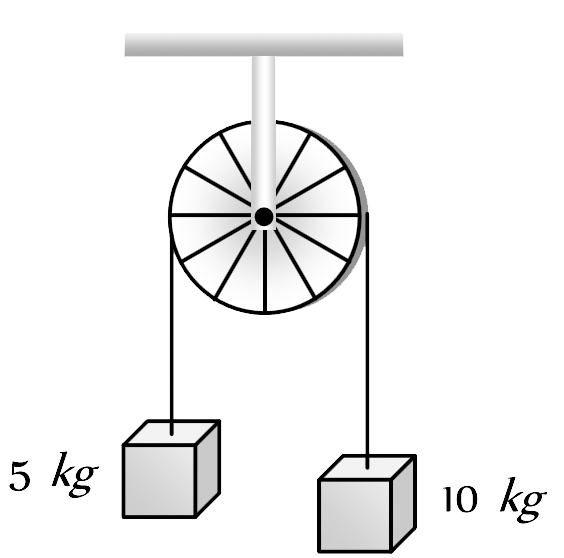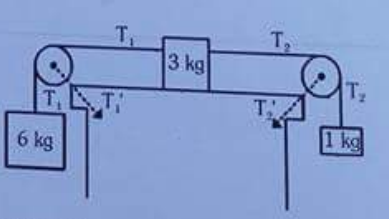The surface are frictionless, the ratio of T1 and T2 is
 Solution in Gujrati
Solution in Gujrati
√3:1
1:√3
1:5
5:1
The correct Answer is:D
a=f×√3230
T2=3×F√32×30
T1=15×F√32×30
∴T1:T2=5:1
Topper's Solved these Questions
- NEWTONS LAWS OF MOTIONBOOK - ALLEN CHAPTER - NEWTONS LAWS OF MOTIONEXERCISE - EXERCISE-III
28 Videos
- NEWTONS LAWS OF MOTIONBOOK - ALLEN CHAPTER - NEWTONS LAWS OF MOTIONEXERCISE - EXERCISE-I
52 Videos
- NEWTON'S LAWS OF MOTION & FRICTIONBOOK - ALLEN CHAPTER - NEWTON'S LAWS OF MOTION & FRICTIONEXERCISE - EXERCISE (JA)
4 Videos
- RACEBOOK - ALLEN CHAPTER - RACEEXERCISE - Basic Maths (Wave Motion & Dopplers Effect) (Stationary waves & doppler effect, beats)
25 Videos
Similar Questions
Assertion: The driver in a vechicle moving with a constant speed on a straight road is in a non-inertial frame of referance.
Reason: A reference frame in which Newton's laws of motion are applicable is non-inertial.
View SolutionUSS 150) Two masses of 5 kg and 10 kg are connected to a pulley as shown. What will be the acceleration of the system (g= acceleration due to gravity)

View SolutionA piece of wire is bent in the shape of a parabola y=kx2 (y-axis vertical) with a bead of mass m on it. The bead can slide on the wire without friction. It stays at the lowest point of the parabola when the wire is at rest. The wire is now accelerated parallel to the x-axis with a constant acceleration a. The distance of the new equilibrium position of the bead, where the bead can stay at rest with respect to the wire, from the y-axis is:
View SolutionThe frequency of a radar is 780 MHz. After getting reflected from an approaching aeroplane, the apparent frequency is more than the actual frequency by 2.6 kHz. The aeroplane has a speed of
View SolutionIf the normals at points t1andt2 meet on the parabola, then t1t2=1 (b) t2=−t1−2t1 t1t2=2 (d) none of these
View SolutionIf a I-order reaction is completed to the extent of 60% and 20% in time intevals, t1 and t2, what is the ratio, t1:t2?
View SolutionA particle takes a time t_(1) to move down a straight tunnel from the surface of earth to its centre. If gravity were to remain constant this time would be t_(2) calculate the ratio (t_(1))/(t_(2))
View SolutionTwo masses m_(1) and m_(2) are accelerated uniformly on a frictionless surface as shown in figure given below. The ratio of the tensions T_(1)/T_(2) is:
View Solution
Calculate a, T1,T2,T1'&T2'.
View SolutionFor a first order reaction, the ratio of t1/2 to t3/4 is
View SolutionTime period of pendulum on earth surface is T_(1) . Its time period at a height equal to radius of earth is T_(2) , then the ratio of T_(1) : T_(2) is
View SolutionTime period of a simple pendulum on the surface of the earth is T1 and at a hight R above the surface of the earth is T2, here R is the radius of the earth. The ratio T2/T1 is
View SolutionBy growth 60^(@) A block on a frictionless plane located at the bottom moves with a break and another block is dropped down from the same point, which is the time t_(2) When it reaches the surface in t_(1):t_(2) is
View SolutionIf t_(1)+t_(2)+t_(3)=-t_(1)t_(2)t_(3) , Then points [at_(1)t_(2),a(t_(1)+t_(2))] , [at_(2)t_(3),a(t_(2)+t_(3))] And [at_(3)t_(1),a(t_(3)+t_(1))] The perpendicular of the triangle with vertices will be
View SolutionA particle takes a time t_(1) to move down a straight tunnel from the surface of earth to its centre. If gravity were to remain constant this time would be t_(2) calculate the ratio (t_(1))/(t_(2))
View SolutionA simple pendulum has a time period T_(1) on the surface of earth of radius R. When taken to a height of R above the earth's surface, its time period is T_(2) , ratio (T_(2))/(T) is
View Solution
